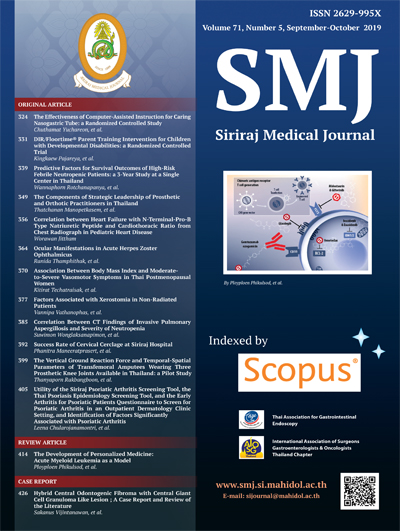Factors Associated with Xerostomia in Non-Radiated Patients
DOI:
https://doi.org/10.33192/Smj.2019.57Keywords:
Xerostomia; underlying disease; medication; non-radiation patientsAbstract
Objective: To identify factors significantly associated with xerostomia in non-radiated patients.
Methods: Patients who attended the outpatient otolaryngology clinic at Siriraj Hospital (Bangkok, Thailand) with complaints of dry mouth were invited to join this study. Collected data included age, gender, body mass index, smoking status, alcohol use, underlying disease, and previous medication and/or therapy. Irradiated patients were excluded. Participants were classified into either the diseased or xerostomia group by abnormal oral cavity examination and symptoms, or the no xerostomia group, which was defined as dry mouth symptoms with no presence of abnormal physical findings.
Results: Two hundred and two participants with a history of dry mouth were consecutively enrolled. There were 86 patients with physical findings compatible with xerostomia, and 116 symptomatic patients without xerostomia. Multivariate analysis revealed age over 50 years (adjusted odds ratio [aOR]: 3.1, 95% confidence interval [CI]: 1.3-7.9; p=0.012), analgesic and muscle relaxant intake (aOR: 3.6, 95% CI: 1.3-9.7; p=0.012), psychotherapeutic medication (aOR: 7.8, 95% CI: 2.6-23.7; p<0.001), and radioactive iodine therapy (aOR: 3.7, 95% CI: 1.2-11.8; p=0.015) to be independent predictors of xerostomia.
Conclusion: Xerostomia is a condition that can adversely affect quality of life. The results of this study revealed older age (≥50 years), analgesics and muscle relaxants, psychotherapeutic medications, and radioactive iodine therapy to be significantly associated with xerostomia. A thorough understanding of the symptoms, diagnosis, relevant risk factors, and effective management is essential for improving outcomes among patients with xerostomia.
Downloads
Published
How to Cite
Issue
Section
License
Authors who publish with this journal agree to the following conditions:
Copyright Transfer
In submitting a manuscript, the authors acknowledge that the work will become the copyrighted property of Siriraj Medical Journal upon publication.
License
Articles are licensed under a Creative Commons Attribution-NonCommercial-NoDerivatives 4.0 International License (CC BY-NC-ND 4.0). This license allows for the sharing of the work for non-commercial purposes with proper attribution to the authors and the journal. However, it does not permit modifications or the creation of derivative works.
Sharing and Access
Authors are encouraged to share their article on their personal or institutional websites and through other non-commercial platforms. Doing so can increase readership and citations.















